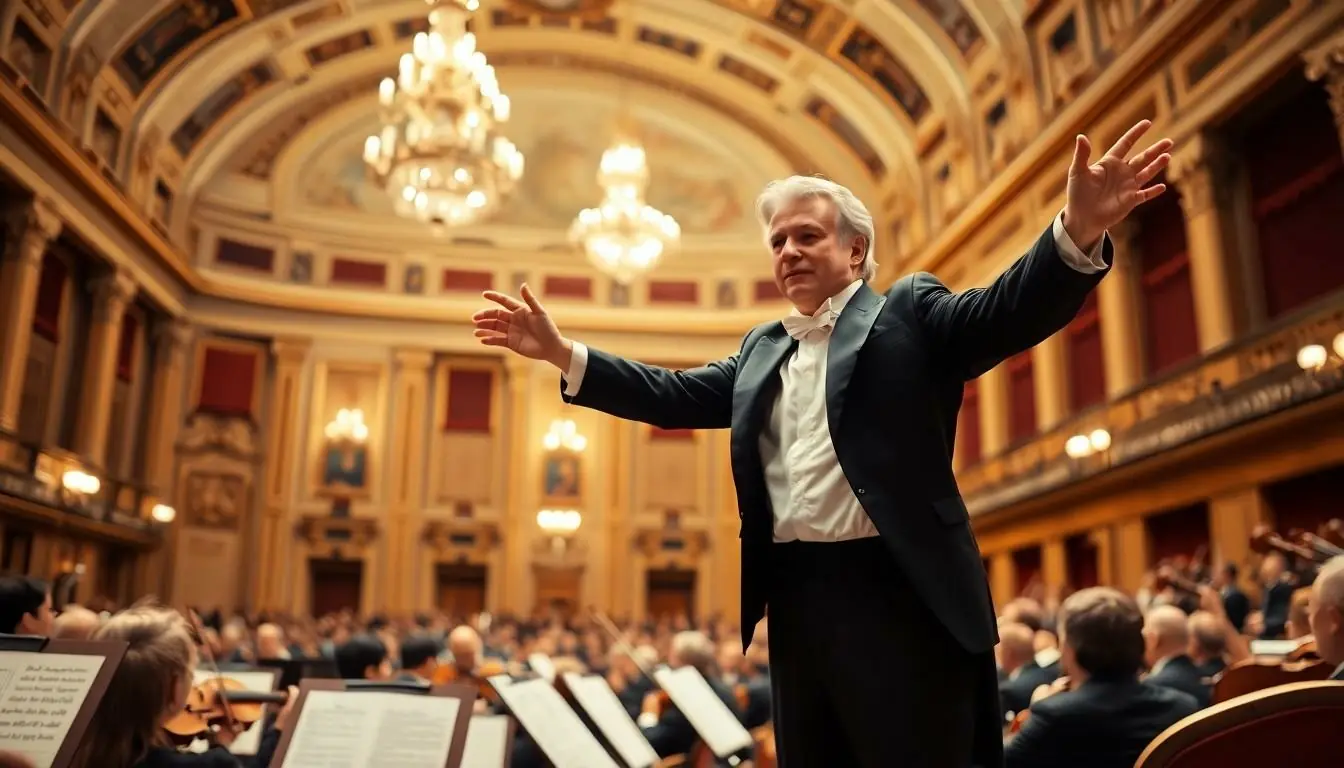Classical music often gets a bad rap, seen as stuffy or reserved for the elite. But let’s face it—who wouldn’t want to channel their inner Beethoven while sipping coffee in their pajamas? This genre is a treasure trove of fascinating facts that could turn even the most skeptical into a fan.
Table of Contents
ToggleOverview of Classical Music
Classical music encompasses a rich tradition that spans centuries, characterized by intricate compositions and structured forms. The genre typically includes works from mutually influential composers such as Bach, Mozart, and Beethoven. Unlike popular music, classical music emphasizes melody, harmony, and orchestration, consisting of symphonies, concertos, sonatas, and operas.
Composers often drew inspiration from various cultural movements and historical contexts, shaping each piece’s distinct style. For instance, the Classical period highlighted balance and clarity, while the Romantic era introduced emotional expression and dynamic contrasts. These shifts reflect society’s evolving tastes and artistic priorities.
Performances often feature orchestras, chamber ensembles, or solo musicians, showcasing the artists’ technical skill and interpretative abilities. Major orchestras, such as the Berlin Philharmonic and New York Philharmonic, serve as prominent representatives of the classical tradition.
Listeners enjoy a diverse range of experiences with classical music. Attending live concerts presents a unique atmosphere, while recordings allow for personal discovery at home or in casual settings. Additionally, film scores frequently incorporate classical elements, introducing new audiences to the genre.
In recent years, classical music has experienced a resurgence in popularity, partly due to innovative initiatives aimed at reaching wider demographics. Festivals, outreach programs, and collaborations with contemporary artists help bridge the gap between traditional and modern appreciation. Ultimately, the depth and variety of classical music resonate with many, offering an endless source of inspiration and enjoyment.
Historical Context

Classical music holds a rich historical narrative rooted in cultures worldwide. Understanding its evolution provides insight into the genre’s profound impact.
Origins of Classical Music
Classical music’s origins trace back to the Medieval period around 500-1400 AD. Chanting and early notations paved the way for structured musical forms. The Renaissance era from 1400-1600 saw greater emphasis on harmony and polyphony, influencing future compositions. Notable figures such as Guillaume Dufay emerged during this time, blending sacred and secular music. By the late 16th century, innovations in instrumentation started to flourish, laying the groundwork for the Baroque period.
Evolution Through the Ages
The Baroque era from 1600-1750 marked a significant shift in musical complexity and expression. Composers like Bach and Vivaldi emphasized ornamentation and contrast. Transitioning into the Classical period (1750-1820), music focused on clarity and balance, with composers such as Mozart and Haydn refining sonata form. The Romantic era (1820-1900) celebrated emotional depth, featuring composers like Chopin and Wagner who pushed thematic boundaries. Ultimately, 20th-century innovations reflected diverse styles and experiments, reshaping classical music and its contemporary relevance.
Prominent Composers and Their Contributions
Classical music features numerous influential composers whose works significantly shaped the genre.
Johann Sebastian Bach
Bach exemplifies Baroque music with his mastery of counterpoint and harmony. His compositions, including the “Brandenburg Concertos” and “Mass in B Minor,” showcase intricate structures. Recognized for enhancing organ music, he also contributed to sacred and secular genres. His “Well-Tempered Clavier” remains essential for pianists, demonstrating his innovative approach to tuning. Scholarship credits him with laying the groundwork for future composers, influencing genres beyond his time.
Ludwig van Beethoven
Beethoven marks the transition from Classical to Romantic music, notable for emotional intensity in his works. His symphonies, particularly the Fifth and Ninth, introduced dramatic expression to orchestral music. Innovations in piano sonatas and string quartets reveal his ability to push boundaries. His life story also inspires, overcoming deafness while composing some of history’s greatest works. Beethoven’s influence persists through later composers who drew on his bold approach and distinct style.
Wolfgang Amadeus Mozart
Mozart stands out for his prolific output and remarkable versatility across genres. His operas, like “The Marriage of Figaro” and “Don Giovanni,” illustrate masterful character development through music. Symphony No. 40 in G minor highlights his ability to blend emotion with clarity. Recognized for refining classical forms, Mozart’s chamber music and concertos infuse varied instrumentation with vibrant melodies. His legacy endures, inspiring generations of musicians and composers through timeless masterpieces.
Key Characteristics of Classical Music
Classical music boasts distinct features that set it apart from other genres. Its complexity and emotional depth attract both dedicated enthusiasts and newcomers.
Structure and Form
Classical compositions often adhere to specific structures, including sonata form, rondo, and ternary forms. Sonata form, structured with exposition, development, and recapitulation, became popular in the Classical period. Rondo, characterized by alternating themes, provides a lively and engaging format. Ternary form, with a three-part structure, creates balance and symmetry in pieces. Each structure allows composers to explore themes and variations creatively, enhancing the listening experience.
Instrumentation
Instrumentation in classical music showcases a range of orchestral instruments, including strings, woodwinds, brass, and percussion. The string section, featuring violins, violas, cellos, and double basses, forms the foundation with rich harmonies. Woodwinds add color with flutes, oboes, clarinets, and bassoons. Brass instruments, like trumpets and trombones, contribute power and brilliance. Percussion instruments, such as timpani and snare drums, provide rhythm and intensity. This diverse instrumentation allows for intricate interactions and dynamic contrasts, creating a rich auditory landscape.
Influence of Classical Music on Modern Genres
Classical music significantly shapes modern genres across various platforms. Popular genres like rock, jazz, and hip-hop draw from classical foundations. For example, rock musicians often incorporate symphonic instruments into their arrangements, blending classic orchestration with contemporary rhythms.
Hip-hop artists sample classical pieces, introducing intricate melodies and harmonies into their tracks. Notable tracks like Nas’s “The Message” utilize strings from classical works, enhancing the lyrical depth. Likewise, jazz has evolved through classical influences, with musicians like Claude Debussy inspiring improvisational styles through rich harmonies.
Film composers frequently refer to classical music for emotional resonance. Iconic scores such as John Williams’ for “Star Wars” exhibit symphonic structures reminiscent of classical compositions. Video game music also adopts classical elements. Composers like Yasunori Mitsuda integrate orchestral themes, creating immersive experiences for players.
Contemporary classical musicians innovate by merging genres. Artists such as Max Richter and Ólafur Arnalds create music that fuses electronic elements with classical traditions. This cross-pollination expands classical music’s reach to new audiences.
The structure of modern pop songs often mirrors classical forms. The verse-chorus format aligns with classical sonata forms, illustrating how classical principles endure in popular music. Electronic genres also reflect classical compositions, using orchestral samples to craft intricate soundscapes.
Classical music’s influence permeates modern genres, transforming compositions and expanding listeners’ experiences. The synergy between classical elements and contemporary styles enriches the musical landscape.
Fun Facts About Classical Music
Classical music boasts a rich history filled with fascinating details. Composers produced an extraordinary number of works across various genres, with over 100 symphonies attributed to Haydn alone. The duration of classical compositions can be extensive; for example, Mahler’s Symphony No. 3 typically lasts around 90 minutes.
Innovatively, Beethoven was among the first composers to incorporate personal emotions in his music, shaping the Romantic era’s emotional depth. Bach meticulously structured his works, leading to over 1,000 identified compositions, showcasing his mastery in counterpoint.
Orchestras vary in size, with a typical symphony orchestra consisting of around 100 musicians. Instruments include strings, woodwinds, brass, and percussion, contributing to classical music’s diverse sound palette. Additionally, famous operas can last several hours, engaging audiences with their dramatic narratives and vibrant scores.
Notably, many classical pieces have had a profound influence on popular culture, with Disney films often featuring orchestral music. Popular songs, such as those by Queen and Led Zeppelin, exhibit strong connections to classical themes and structures. Moreover, the “Pachelbel’s Canon” has become a staple at weddings, illustrating its lasting appeal.
Even today, classical music endures through innovative collaborations between modern artists and classical musicians. Festivals frequently celebrate classical compositions, attracting diverse audiences and fostering a renewed appreciation. Record labels actively promote contemporary classical composers, expanding the genre’s reach to new listeners worldwide.
Exploring classical music’s legacy reveals an endless source of inspiration, ensuring its relevance in today’s musical landscape.
Classical music stands as a timeless genre that continues to inspire and captivate audiences across generations. Its rich history and intricate compositions reveal a world of emotion and creativity that transcends cultural boundaries. The genre’s ability to evolve while maintaining its core principles ensures its relevance in today’s diverse musical landscape.
Listeners are encouraged to explore classical music in various settings, whether at home or in concert halls, to fully appreciate its depth and beauty. As classical music intersects with modern genres and contemporary artists, its legacy remains vibrant, inviting new fans to discover the magic within its notes. Embracing classical music opens doors to a profound auditory experience that resonates deeply with the human spirit.


